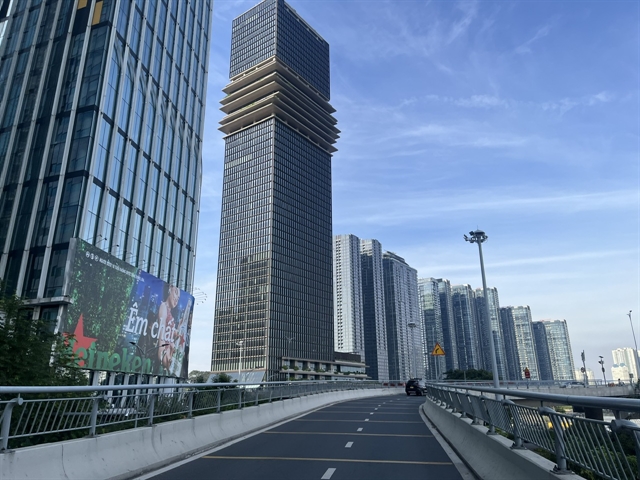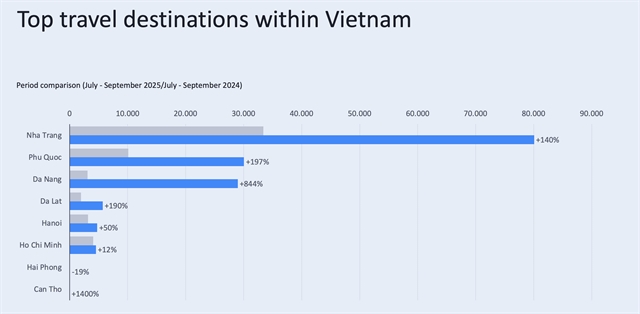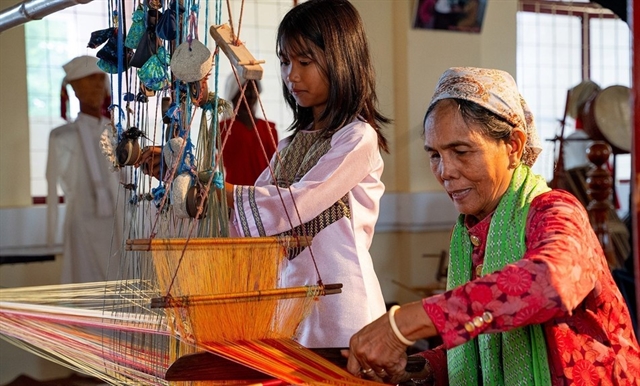 Features
Features

To boost sustainable tourism development, the People’s Committee of Hà Nội has planned to develop an agricultural and rural tourism plan in tandem with building new-style rural areas in 2022–2025.
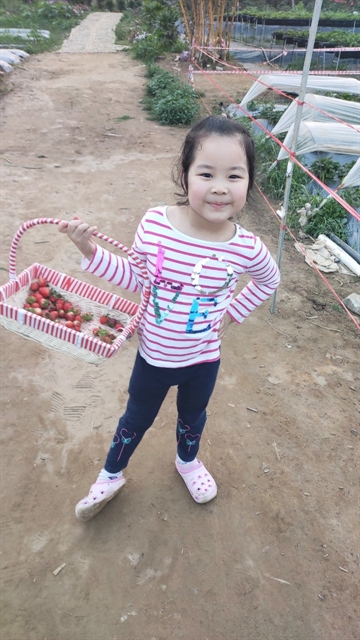
|
| Nguyễn Phương Hà with the ripe strawberries that she harvested at Chimi Farm. VNS Photo Lương Hương |
Holding a basket in their hands, eight-year-old Nguyễn Phương Hà and her parents eagerly look through luxuriant green leaves to search for ripe red strawberries. Her eyes sparkle with joy as her basket is gradually filled with fruit.
The family are spending a day picking strawberries at Chimi Farm Hanoi, located by the west bank of the Hồng (Red) River in Hà Nội’s Tây Hồ District. Since its opening in 2018, the 3,000 sq.m strawberry farm has become a regular weekend destination for young people and families looking for a farming experience on the outskirts of the city.
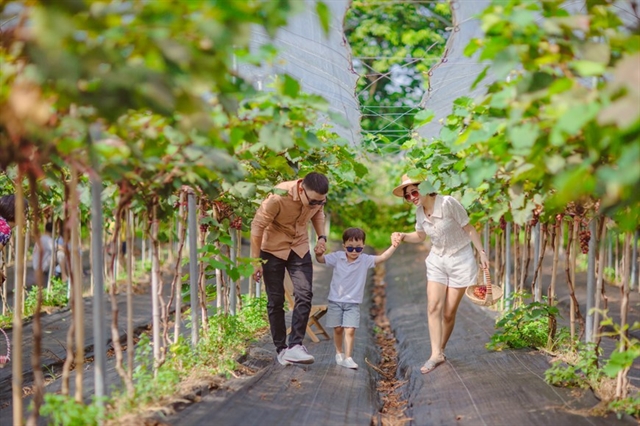
|
| Visitors at Chimi Farm. VNA/VNS Photo Minh Sơn |
Besides picking the berries, visitors can also learn how to grow strawberry plants and make strawberry yoghurt and other drinks from the fruit.
“They can enjoy drinks at the cafe in the farm,” said Nguyễn An Phương, sales manager of the farm.
“Taking photos is free of charge. You pay for the fruit you pick and the drinks,” she added.
Nguyễn Huy Hiệp, Hà’s father, said his daughter enjoyed the farm activities immensely.
“She gets excited about looking for ripe red strawberries and picking them,” Hiệp said, adding that the child burst into laughter whenever she found an odd-shaped fruit or a worm under the leaves.
“My daughter and I had a good time at the farm as she had the opportunity to play outdoors and get closer to nature after days of staying at home due to the pandemic,” Hiệp said.
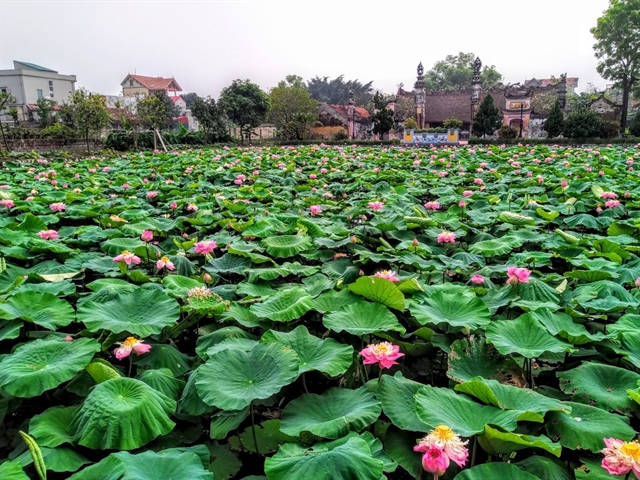
|
| A peaceful corner in Hồng Vân Commune. Photo ceford.vn |
Located in Hà Nội’s outlying district of Thường Tín, Hồng Vân Commune is another example of success in combining agriculture, traditional crafts and tourism.
In recent years, the commune, which is famous for ornamental plants, has received about 70,000 visitors every year, with tourism revenue topping VNĐ10 billion (US$438,000).
According to Nguyễn Hải Đăng, secretary of Hồng Vân Commune’s Party Committee, the locality was recognised as a 'new-style' rural area in 2014, and it fulfilled all the criteria of being an advanced 'new-style' rural area in 2019.
The local authorities have focused on agriculture and eco-tourism development to create breakthroughs in its economic growth, providing new travel services and products.
According to Tạ Văn Tường, vice director of the municipal Department of Agriculture and Rural Development, Hà Nội has 11 eco-agriculture farms operating under the education and experiential tourism model, and four involving agritourism.
Many different models of eco-agriculture combined with tourism have brought economic efficiency, helping improve the living standards of locals while giving rural areas a facelift.
Strategic task
Vice director Tường said that the development of eco-agricultural tourism towards in-depth new rural areas was an important, strategic task for Hà Nội.
“However, these models have not been properly developed in parallel with the city’s strength and potential,” Tường said.
The main issues include a lack of connection between the development of the models and rural planning and problems emerging during the planning adjustment, according to Tường. The current policy of attracting investment in eco-agriculture does not match the reality of actual development.
Professor of biology Nguyễn Lân Dũng noted that Hà Nội had a long-standing eco-agricultural background as it is known as “the land of a hundred traditional crafts”.
It is estimated that the city is now home to 1,350 craft villages, which create significant benefits for agritourism.

|
| A tourist at Bát Tràng Pottery Village makes his own product. VNA/VNS Photo Thanh Tùng |
“Hà Nội needs to exploit that particular strength and at the same time, promote organic agriculture in association with eco-tourism, aiming to build a comprehensively sustainable new countryside,” he said.
According to Đào Thế Anh, vice director of the Việt Nam Academy of Agricultural Sciences, the city needs to complete a master plan for rural tourism development, creating solid motivation for eco-agriculture tourism development and building new rural areas.
He said that attention should also be paid to market research, new products and services, promotion and technology application, infrastructure development, and human resources.
To boost sustainable tourism development, the People’s Committee of Hà Nội has planned to develop an agricultural and rural tourism plan in tandem with building new-style rural areas in 2022–2025.
In the plan, each suburban district with advantages in agritourism will develop one to three community-based tourism services or sites, with at least 50 per cent of products registered for intellectual property protection and recognised as three-star or higher products under the “One Commune, One Product” (OCOP) programme.
Each potential locality will build at least one agritourism connectivity model involving farmers, cooperatives, business households, and enterprises.
The city will also provide training for at least 80 per cent of the workforce at local tourism facilities and villages, for officials in charge of tourism management, and other stakeholders in agritourism.
The municipal administration will develop six models of green and sustainable agritourism in the suburban districts of Thường Tín, Đan Phượng, Thanh Trì, Mỹ Đức, and Thạch Thất, as well as Sơn Tây town.
Authorities will conduct surveys to collect information about the agritourism market while developing software for analysing statistics to serve tourism planning and management.
They will select and help develop community-based tourism destinations linked with traditional craft villages, along with models of community-based tourism, eco-agritourism, and culinary and cultural tourism.
To promote digital transformation in tourism, Hà Nội will form smart agricultural villages and rural tourism, creating software for managing and advertising tourism and farm produce, and digitalising travel information centres.
The municipal authorities require localities to identify the existing rural tourism destinations that have received support and those being developed while clarifying their advantages and difficulties, to give appropriate assistance.
Another important measure is to step up communications to raise public awareness of agritourism and new-style rural areas and update residents on tourism planning, legal regulations, and the code of conduct in public.
Hà Nội is planning to bolster new tourism products based on the potential of each area in a bid to resume the entire tourism sector gradually this year.
Apart from agritourism, other types such as resort and health tourism, and community and spiritual tourism will also be prioritised in the capital's rural areas.
“Along with issuing a plan for developing agritourism in combination with new-style rural areas in 2021, the municipal authorities have taken a series of measures to attract investment in the field,” said Vice Chairman of the municipal People’s Committee Nguyễn Mạnh Quyền.
This year, Hà Nội will focus on the domestic tourism market, using this as motivation for recovery.
It plans to gradually resume tourism, aiming to welcome 9-10 million visitors this year, including 2 million foreigners.
The capital city set a target of earning VNĐ27.84 trillion to 35.84 trillion from the industry this year.
Data from the Hà Nội People’s Committee show that COVID-19 has taken a heavy toll on local tourism.
The number of domestic visitors to Hà Nội totalled 4 million last year, plunging to about 47 per cent of 2020 and equivalent to just 36.3 per cent of the yearly target.
Tourism revenue nosedived some 59.8 per cent year-on-year to VNĐ11.28 trillion.
By enhancing agritourism, the city is hoping for a brighter, greener future. VNS

